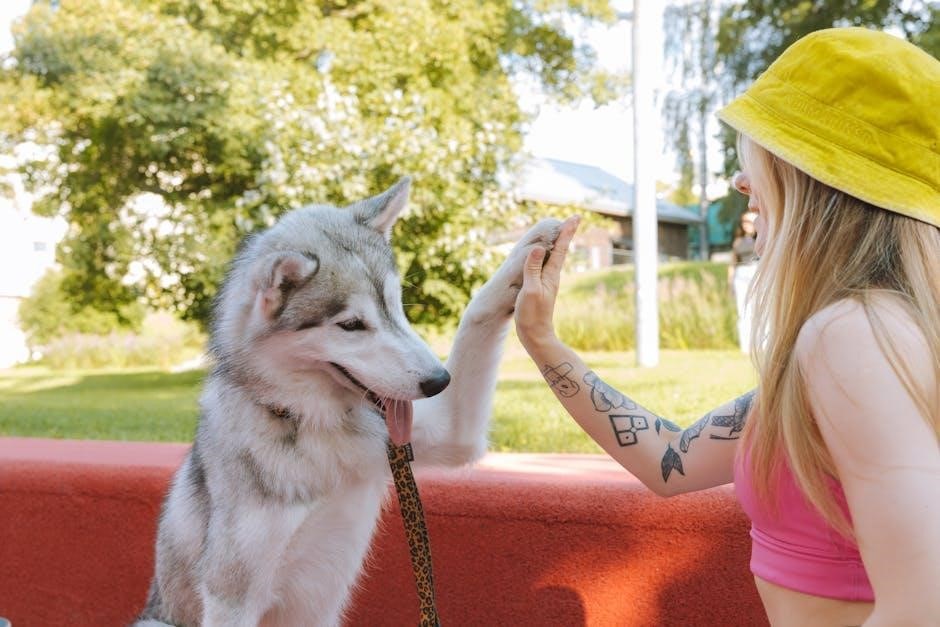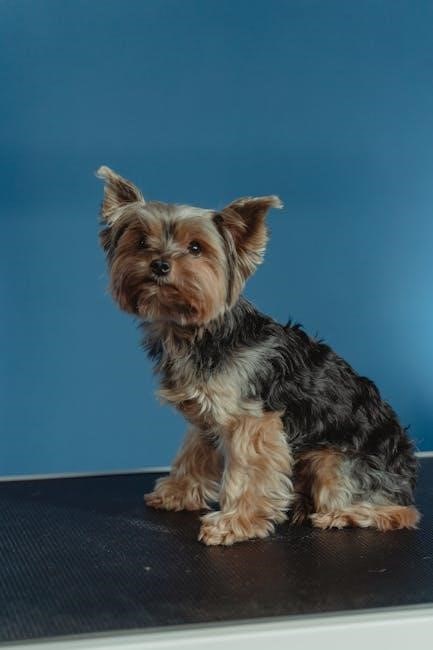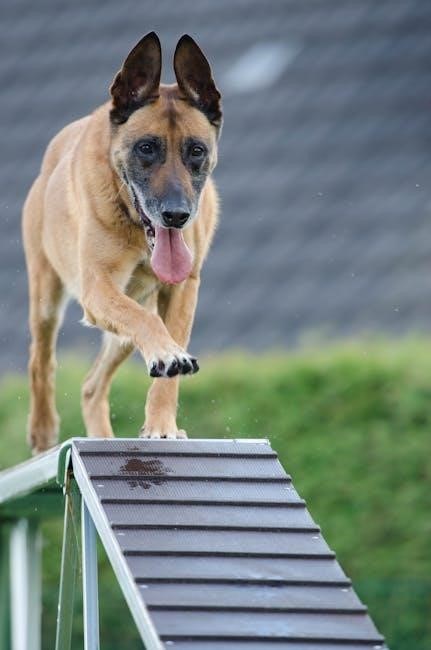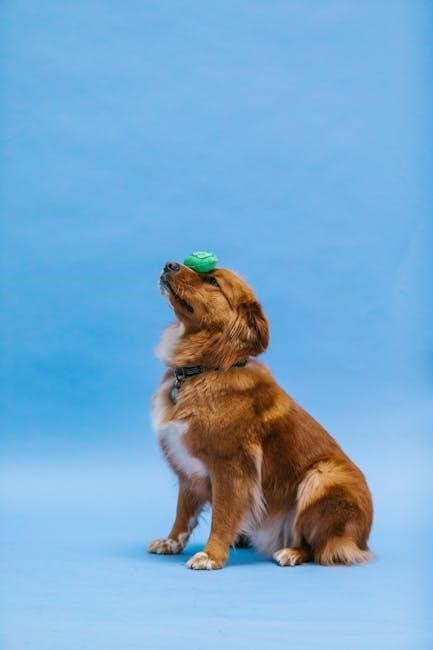Dog training commands establish clear communication between you and your pet, building trust and consistency. They create a foundation for basic obedience and more complex tasks, fostering a lifelong bond through positive reinforcement and mutual understanding.
1;1 Importance of Dog Training
Dog training is essential for establishing a strong bond between you and your pet. It reduces stress, improves communication, and helps your dog become a well-behaved companion. Training lays the foundation for basic obedience, advanced tasks, and even tricks, ensuring a lifelong connection built on trust, consistency, and mutual understanding.
1.2 Benefits of Using a Commands List
A commands list provides clarity and structure for dog training, ensuring consistency and effectiveness. It helps owners stay organized, track progress, and maintain focus on essential skills. By having a clear guide, owners can avoid confusion and ensure their dog learns necessary behaviors efficiently. This structured approach fosters better communication and accelerates the learning process for both the dog and the trainer.
Basic Dog Training Commands
Basic commands like Sit, Stay, Come, Down, and Heel form the foundation of dog training, teaching essential obedience and setting the stage for more advanced skills.
2.1 Sit
The “Sit” command is a fundamental skill where your dog learns to lower its hindquarters into a seated position. Hold a treat above their head, move it backward toward their tail, and say “Sit.” As they follow the treat with their nose, their bottom will lower. Reward with the treat and praise. Consistency and patience are key to mastering this basic yet essential command.
2.2 Stay
The “Stay” command teaches your dog to remain in a stationary position, such as sitting or lying down, without moving. Start by having your dog sit, take a few steps back, and say “Stay.” Gradually increase the distance and time. Use a hand signal, like an open palm, to reinforce the command. Consistency and positive reinforcement are essential for mastering this foundational skill.

2.3 Come
The “Come” command is crucial for recalling your dog in any situation. Start by calling your dog by name, followed by “Come,” and reward them with treats or praise. Gradually increase the distance and distractions. Consistency and positive reinforcement are key to ensuring your dog responds promptly and reliably, even when off-leash or in challenging environments, fostering trust and safety.

2.4 Down
The “Down” command teaches your dog to lie down on command. Start with your dog in a “Sit,” then lure them into a downward position by moving a treat down and back towards their tail. Once they lie down, say “Down” and reward them. Consistency and positive reinforcement are essential to help your dog learn this command effectively and respond quickly in any situation.
2.5 Heel
The “Heel” command teaches your dog to walk beside you without pulling on the leash. Start with your dog sitting by your left side. Take a few steps forward, saying “Heel,” and reward them for staying close. Gradually increase the distance and distractions, ensuring they remain focused on you. Consistency and practice will help your dog master this essential command for walks and obedience.

Advanced Dog Training Commands
Advanced commands build on basic obedience, introducing complex tasks like “Leave It” and “Fetch.” These commands enhance your dog’s problem-solving skills and strengthen your bond through challenging, engaging exercises.
3.1 Leave It
The “Leave It” command teaches your dog to ignore or leave an object, reducing unwanted behavior like stealing food or picking up dangerous items. Start by placing a treat in front of your dog and saying “Leave It.” When they resist the temptation, reward them with another treat. Gradually increase difficulty by using more enticing objects. Consistency and patience are key to mastering this command, ensuring your dog learns self-control and responds reliably in various situations.
3.2 Drop It
The “Drop It” command helps your dog release items they’re holding, preventing potential harm or damage. Introduce the command by offering your dog a toy and exchanging it for a treat. Encourage them to release the toy by saying “Drop It” and rewarding them when they comply. Over time, phase out treats, using praise and occasional rewards to maintain the behavior, ensuring your dog learns to let go willingly and safely in various scenarios.
3.3 Wait

The “Wait” command instructs your dog to pause momentarily, often before actions like entering a room or eating. Start by having your dog sit or stand, then take a few steps back while saying “Wait.” Gradually increase the distance and duration. Reward them when they remain still. This command helps with impulse control and is useful in everyday situations, ensuring your dog waits calmly before proceeding, fostering patience and self-control through consistent practice and positive reinforcement, making it a valuable tool for maintaining good behavior in various scenarios, both at home and in public settings, while reinforcing your leadership and their ability to focus, even when distractions are present, helping to prevent unwanted behavior and ensuring safety by giving them a clear instruction to hold their position temporarily, allowing you to manage situations effectively, such as before crossing streets or entering crowded areas, where a moment’s pause can make a significant difference in safety and overall behavior management, proving to be an essential command for any well-trained dog, enhancing their ability to respond to cues in a variety of contexts, from casual walks to more structured training sessions, and beyond, as they learn to trust and follow your guidance without hesitation, creating a stronger bond between you and your pet through clear communication and consistent training practices, ultimately leading to a more obedient and well-behaved companion, capable of handling a wide range of situations with confidence and poise, thanks to the foundation built by this simple yet powerful command, which serves as a cornerstone for more advanced training and real-life applications, ensuring your dog remains calm and patient, even in the face of distractions or temptations, by providing a clear and consistent instruction that they can rely on, helping to reduce anxiety and stress in both the dog and the handler, as they navigate the world together with greater ease and understanding, fostering a relationship built on trust, respect, and effective communication through the use of this and other essential commands, each playing a vital role in the overall training process, and contributing to the development of a well-rounded, obedient, and loyal pet, capable of thriving in various environments and situations, with the “Wait” command serving as a key component in their behavioral toolkit, providing a moment of pause that allows for better decision-making and safer outcomes, while reinforcing the importance of following commands, even when the urge to act impulsively arises, ensuring that your dog remains a well-behaved and trustworthy companion, always ready to respond to your guidance, and creating a more harmonious and enjoyable relationship between you and your pet, as they learn to navigate the world with patience and self-control, thanks to the consistent practice and positive reinforcement of this valuable command, which serves as a testament to the power of effective training and clear communication in shaping the behavior of your dog, and enhancing their ability to function calmly and obediently in a wide range of situations, from the simplest tasks to the most challenging environments, where a moment’s pause can make all the difference in ensuring safety, order, and mutual understanding between you and your pet, as you work together to build a lifelong bond based on trust, respect, and the consistent application of well-learned commands like “Wait,” which plays a crucial role in their training and daily life, providing a foundation for more advanced skills and reinforcing the principles of obedience and self-control that are essential for any well-trained dog, and helping to create a more peaceful and enjoyable living situation for both you and your pet, as they learn to wait patiently and respond to your instructions without hesitation, even in the face of distractions or temptations, ultimately leading to a more fulfilling and rewarding relationship built on clear communication and mutual understanding, as you guide your dog through the world with confidence and ease, thanks to the power of this simple yet effective command, which serves as a cornerstone for their training and behavior, helping them to grow into a well-behaved and loyal companion, capable of handling a wide range of situations with patience and grace, and always ready to respond to your guidance with confidence and trust, creating a lasting bond that enriches both your lives through the consistent practice and positive reinforcement of this essential command, which plays a vital role in their development and your ability to work together seamlessly, ensuring that your dog remains a source of joy and companionship for years to come, as they learn to wait, listen, and respond to your instructions with precision and obedience, making every interaction a positive and rewarding experience, and reinforcing the importance of clear communication and consistent training in shaping their behavior and fostering a lifelong partnership based on trust, respect, and the effective use of commands like “Wait,” which serve as a testament to the transformative power of patience, consistency, and positive reinforcement in dog training, and the incredible bond that can be built between a dog and their handler through the careful teaching and application of these essential skills, ultimately leading to a more harmonious and enjoyable relationship that brings joy and fulfillment to both parties, as they navigate the world together with confidence and ease, thanks to the strong foundation built through the consistent practice of this and other vital commands, which serve as the building blocks for a lifetime of learning, growth, and companionship, and remind us of the profound impact that clear communication and consistent training can have on the behavior and well-being of our pets, as well as the strength of the bond we share with them, a bond that is nurtured and reinforced through the careful teaching and application of commands like “Wait,” which play a crucial role in their development and our ability to guide them through the world with patience, understanding, and confidence, ensuring that they grow into well-behaved and loyal companions, capable of thriving in a variety of environments and situations, and always ready to respond to our guidance with trust and obedience, creating a lasting and fulfilling relationship that enriches both our lives through the power of effective training and clear communication, and serving as a testament to the incredible potential of dogs to learn, grow, and flourish when given the proper tools and guidance, with commands like “Wait” serving as a key component in their behavioral toolkit, and a powerful reminder of the importance of patience, consistency, and positive reinforcement in shaping their behavior and fostering a lifelong partnership based on trust, respect, and mutual understanding, ultimately leading to a more joyful and rewarding relationship between you and your pet, as you work together to navigate the world with confidence and ease, thanks to the strong foundation built through the consistent practice and application of this essential command, and the countless benefits it brings to both the dog and the handler, in terms of communication, trust, and the ability to work together seamlessly in a wide range of situations, from the simplest tasks to the most challenging environments, where a moment’s pause can make all the difference in ensuring safety, order, and mutual understanding, and reinforcing the importance of clear communication and consistent training in shaping the behavior of your dog, and fostering a lifelong bond based on trust, respect, and the effective use of commands like “Wait,” which serve as a cornerstone for their training and behavior, helping them to grow into a well-behaved and loyal companion, capable of handling a wide range of situations with patience and grace, and always ready to respond to your guidance with confidence and trust, creating a lasting and fulfilling relationship that enriches both your lives through the consistent practice and positive reinforcement of this valuable command, which plays a vital role in their development and your ability to work together seamlessly, ensuring that your dog remains a source of joy and companionship for years to come, as they learn to wait, listen, and respond to your instructions with precision and obedience, making every interaction a positive and rewarding experience, and reinforcing the importance of clear communication and consistent training in shaping their behavior and fostering a lifelong partnership based on trust, respect, and the effective use of commands like “Wait,” which serve as a testament to the transformative power of patience, consistency, and positive reinforcement in dog training, and the incredible bond that can be built between a dog and their handler through the careful teaching and application of these essential skills, ultimately leading to a more harmonious and enjoyable relationship that brings joy and fulfillment to both parties, as they navigate the world together with confidence and ease, thanks to the strong foundation built through the consistent practice of this and other vital commands, which serve as the building blocks for a lifetime of learning, growth, and companionship, and remind us of the profound impact that clear communication and consistent training can have on the behavior and well-being of our pets, as well as the strength of the bond we share with them, a bond that is nurtured and reinforced through the careful teaching and application of commands like “Wait,” which play a crucial role in their development and our ability to guide them through the world with patience, understanding, and confidence, ensuring
3.4 Fetch
The “Fetch” command encourages your dog to retrieve an object, promoting physical exercise and mental stimulation. Start by throwing a toy and prompting your dog to bring it back. Use a favorite item and reward returns with praise or treats. Gradually increase distance and complexity. This command enhances retrieval skills, provides entertainment, and reinforces obedience, while strengthening your bond and encouraging active play, making it an engaging and beneficial activity for dogs of all ages, helping to burn energy and improve focus through consistent practice and positive reinforcement, ensuring your dog learns to retrieve and return reliably, while enjoying quality time together, and fostering a fun, interactive way to exercise and train, with clear commands and consistent practice leading to successful retrieval and a stronger connection between you and your pet, as they learn to trust and respond to your instructions eagerly, creating a enjoyable and rewarding experience for both parties involved, and proving to be an essential command for any dog, regardless of size or breed, as it promotes physical health, mental stimulation, and a deeper understanding of teamwork and communication, while also providing an outlet for natural instincts and playful behavior, making it a cornerstone of a well-rounded training regimen, and a testament to the power of positive reinforcement in shaping desired behaviors, as your dog learns to fetch, retrieve, and return, building a lifelong skill that brings joy and satisfaction to both you and your pet, and serving as a reminder of the importance of consistent training, clear communication, and the unwavering bond between a dog and their handler, as they work together to master this fun and rewarding command, which not only enhances their physical and mental well-being but also strengthens the connection they share, creating a more harmonious and enjoyable relationship built on trust, respect, and the shared joy of playful interaction, and proving that with patience, consistency, and positive reinforcement, even the simplest commands can lead to profound benefits for both the dog and the handler, as they embark on a journey of learning, growth, and companionship, with the “Fetch” command serving as a timeless and universal tool for fostering engagement, exercise, and understanding, and reminding us of the countless ways in which dogs enrich our lives through their loyalty, intelligence, and willingness to learn, making every training session an opportunity to deepen our bond and create lasting memories with our loyal companions, as they learn to fetch, retrieve, and return, bringing joy and fulfillment to both ends of the leash, and highlighting the transformative power of training in shaping the behavior and well-being of our pets, as well as the strength of the human-animal bond, which flourishes through clear communication, consistent practice, and the shared joy of activities like fetch, a command that not only teaches a skill but also nurtures a lifelong friendship, and serves as a testament to the incredible potential of dogs to learn, grow, and thrive when given the proper guidance and care, as they bring endless joy and companionship into our lives, and remind us of the profound impact that patience, consistency, and positive reinforcement can have on their development and our relationship with them, as we work together to master commands like “Fetch,” which become more than just a trick, but a way to connect, communicate, and build a stronger, more meaningful bond, one throw at a time, creating a legacy of trust, respect, and mutual understanding that will last a lifetime, and bringing immeasurable joy and fulfillment to both the dog and the handler, as they explore the world together, one fetch at a time, and continue to grow and learn as a team, united by the shared love of playful interaction and the unbreakable bond that forms through consistent training and positive reinforcement, proving that even the simplest commands can lead to the most profound connections, and that the journey of training a dog is not just about teaching skills, but about building a lifelong partnership based on trust, respect, and the shared joy of learning and growing together, with every fetch, every retrieve, and every return, strengthening the ties that bind us to our loyal companions, and creating a more fulfilling and enjoyable relationship for all involved, as we embark on this incredible journey of training, bonding, and discovery, one command at a time, with “Fetch” serving as a timeless reminder of the power of patience, consistency, and positive reinforcement in shaping the behavior of our pets, and the incredible rewards that await us when we invest time and effort into their training, leading to a more harmonious, enjoyable, and rewarding relationship that enriches both our lives and the life of our loyal pet, as they learn to fetch, retrieve, and return, bringing endless joy and satisfaction to our daily interactions, and reinforcing the importance of clear communication, consistent practice, and the unwavering bond between a dog and their handler, as we work together to master this fun and engaging command, and create a lasting legacy of trust, respect, and mutual understanding, one fetch at a time, proving that with patience, consistency, and positive reinforcement, even the simplest commands can lead to profound benefits for both the dog and the handler, and that the journey of training a dog is not just about teaching skills, but about building a lifelong partnership based on trust, respect, and the shared joy of learning and growing together, with every fetch, every retrieve, and every return, strengthening the ties that bind us to our loyal companions, and creating a more fulfilling and enjoyable relationship for all involved, as we embark on this incredible journey of training, bonding, and discovery, one command at a time, with “Fetch” serving as a timeless reminder of the power of patience, consistency, and positive reinforcement in shaping the behavior of our pets, and the incredible rewards that await us when we invest time and effort into their training, leading to a more harmonious, enjoyable, and rewarding relationship that enriches both our lives and the life of our loyal pet, as they learn to fetch, retrieve, and return, bringing endless joy and satisfaction to our daily interactions, and reinforcing the importance of clear communication, consistent practice, and the unwavering bond between a dog and their handler, as we work together to master this fun and engaging command, and create a lasting legacy of trust, respect, and mutual understanding, one fetch at a time.
3.5 Walking on a Leash
Teach your dog to walk calmly on a leash by starting with short sessions and using positive reinforcement. Reward good behavior with treats or praise. Avoid pulling back if your dog pulls, as this can create resistance. Instead, stop and encourage your dog to return to your side before continuing. Practice regularly to help your dog understand the expectation of walking beside you without tugging. This command improves communication and reduces stress during walks, fostering a more enjoyable experience for both you and your dog. Consistency is key to mastering this skill, ensuring your dog learns to walk politely on a leash, which is essential for public outings and maintaining a strong bond. Be patient and celebrate small progress to build a reliable walking routine, making leash walks a positive and stress-free activity for both of you, while strengthening your connection and trust through consistent practice and clear communication.
